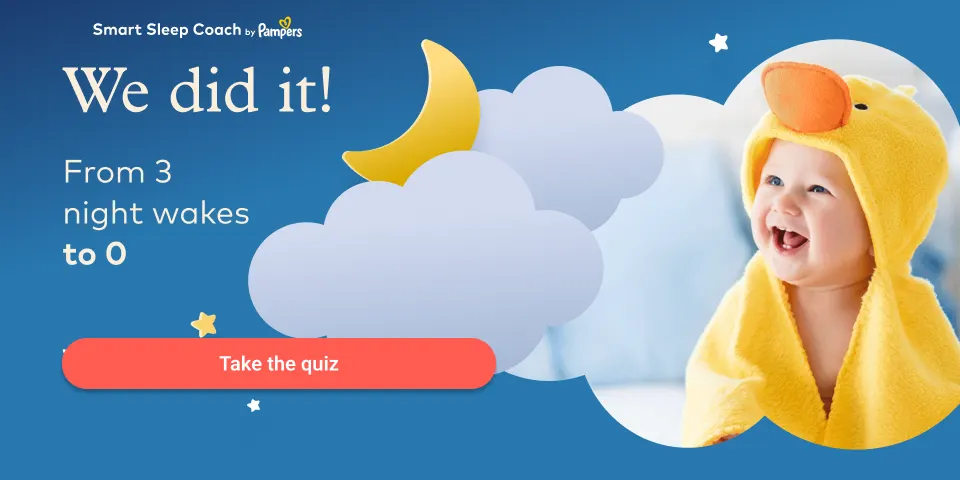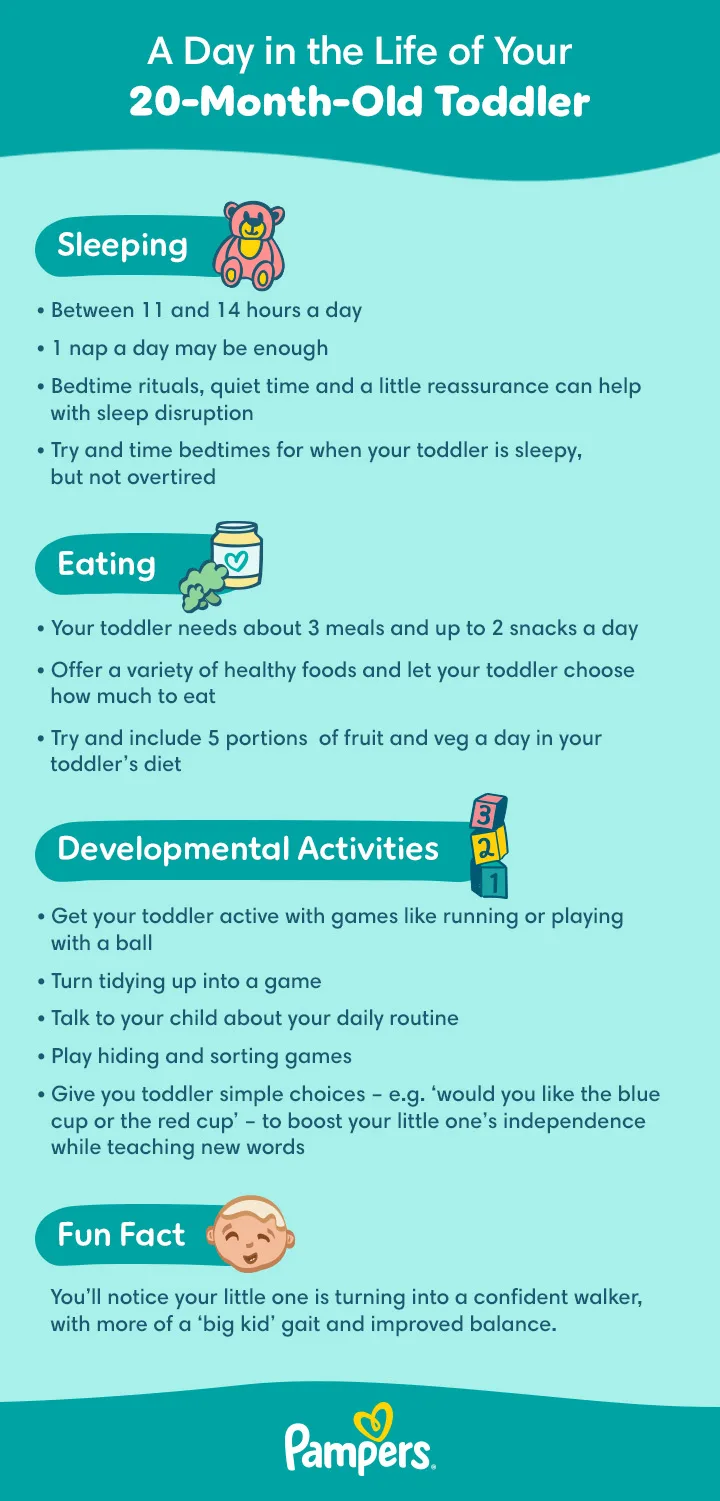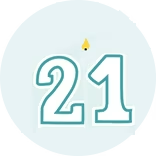20-Month-Old: Gaining Independence
For your toddler, being 20 months old is all about exploration and discovery. Scroll down to learn more about upcoming developmental milestones such as how your child’s speech and other skills could be evolving this month. Find out what activities could help support your little one’s development.
Toddler Development Milestones
You’ll notice your toddler is learning new things all the time now, and this month is no exception. Although each child develops at a different pace, these are a few of the things you might notice at or around 20 months old.
Speech at 20 months old: Putting Words Together
Sometime around 20 months old, your toddler may start joining words together to make simple ‘sentences’, like ‘mummy drink’ or ‘where teddy?’ And that’s not all: Your child may also now be able to follow simple instructions too.
Try asking your little one to do simple tasks, like ‘bring your cup’ or ‘get the book’. It doesn’t matter if your toddler doesn’t always do what you say. Your little one learns a lot by repetition, so he or she might have to hear the same phrases many times before joining up the dots.
Keep in mind that children learn to talk at different rates, so don’t get worried if your 20-month-old is not talking as much as other children around the same age. Talk to your health visitor if you’re concerned about speech or any other aspect of your toddler’s development.
Movement: Picking Up Speed
You might find it’s getting harder to keep up with your 20-month-old toddler as he or she starts (or gets better at) running. Going up and down stairs could also be getting easier for your child, so make sure you’re always there to supervise and keep stairs and other hazardous areas safe for your toddler with baby gates and other baby-proofing measures.
Social Development: Onlooker/Spectator Behaviour
At 20 months old, your toddler may still be playing alone, but it might not be long before your child starts watching other children play (but without joining in). This particular milestone is often reached at around the age of 2 years old, but every child is unique so it could happen earlier or later than that.
This curiosity is known as ‘onlooker’ or ‘spectator’ behaviour, and it means your toddler is almost ready to move onto the next stage of social development known as parallel play – when your child will start playing alongside another child or children, sometimes imitating them but without interacting just yet.
Emotional Development: Growing Independence
It’s magical to see your toddler growing more independent by the day, but this can also be a challenge sometimes as your child starts testing the boundaries of what is and what isn’t allowed.
Signs of this early rebelliousness could be spitting out food your little one doesn’t like or refusing to cooperate during nappy changes. You may also start to experience full-blown temper tantrums, with screaming, rolling around on the floor and sometimes even kicking and biting.
This stage of development, sometimes known as the ‘terrible twos’ can be challenging at times – especially when your toddler goes into meltdown in a public place like a shop. Take heart though, the ‘terrible twos’ aren’t all terrible – this phase of toddlerhood is full of magical moments too – and even the tantrums are just a normal part of growing up.
Here are some tips for dealing with toddler tantrums:
Find out what’s behind the meltdown. Your toddler might be hungry, tired, or just in need of a cuddle. A snack, a rest or a hug could be all it takes to cheer your little one up again.
Distract your child. In the early stages of a tantrum, you might be able to grab your toddler’s attention by pointing out something interesting: ‘look: cows!’ Try and sound as surprised as possible yourself for maximum effect.
Wait for it to blow over. Resist the temptation to fight fire with fire – shouting back won’t end the tantrum. Smacking is never a good idea and makes things worse in the long term. Just ignoring the tantrum (and any disapproving looks from passers-by) is sometimes the best strategy. In some cases – especially if your child is upset rather than angry – it can help to hold your little one gently but firmly until the tantrum fizzles out.
Don’t give in. Once you’ve said no to something, stick to your guns. Changing your mind sends out a message that tantrums work. That said, you can still show that you understand how your little one feels by saying things like ‘I know you’re feeling cross...’ or ‘I can see you’re upset...’
How to Support Your Toddler’s Development
There are plenty of activities you can try to encourage and support your toddler’s development at 20 months old. Here are a few suggestions:
Establish a daily routine. Your toddler loves knowing what’s going and what’s going to happen. Let your child ‘help out’ with day-to-day tasks. Talk to your little one about what you are doing, and why. Explain what you’re going to do next. If you like, you could make up little songs about doing daily chores and encourage your child to sing along with you.
Use repetition to boost speech development. Repeating words lots of times can help your toddler remember them more easily. One way of doing this is to use the same word in lots of sentences. For example: ‘Would you like to wear red socks?’ ‘Where are your red socks?’ ‘Those red socks are really pretty!’
Give choices. Giving your toddler simple choices can help make him or her feel more independent, which may even help make tantrums and challenging behaviour less frequent.
Play with a ball. Rolling, kicking and throwing a ball around is great fun for your toddler, and besides helping to work off any excess energy it’s fantastic for developing movement, balance and coordination. Your child may find it easier to manage a large, soft ball at first. Later you can try various different sizes. If your toddler has trouble catching or stopping a proper ball, try with a slower-moving balloon.
Blow bubbles. Your toddler will love chasing after soapy bubbles and trying to pop them.
Work off some energy with active play. Simple games like ‘tag’ and ‘follow my leader’, or just chasing each other around the garden are a fun way of letting off steam while mastering balance and coordination.
Play hiding and sorting games. Games where you hide different items and your toddler has to find them are great for boosting your little one’s deductive skills. Try the ‘cups and ball’ game by hiding a small toy under one of two cups and moving them around, then asking where the toy is. At around 20 months old your toddler may enjoy sorting games, where your child has to post different-shaped blocks through matching holes – great both for thinking and for fine motor skills development.
Mealtimes for Your 20-Month-Old Toddler
Make sure your growing toddler gets a healthy mix of nutritious foods by offering three meals and two healthy snacks a day. Don’t worry if your little one doesn’t always accept a new food the first time, just try it again a few weeks later – your toddler’s tastes can change from month to month!
It’s important to offer your child some food from each of the main food groups (fruit and veg, starchy foods, protein and dairy or alternatives), but this doesn’t mean every meal has to contain a perfect balance of each. It’s normal for children to sometimes leave some things on the plate sometimes.
Over longer periods of a few days or a week you’ll probably find that things balance out naturally if you always offer a good mix of flavours and textures. If your child seems well, is active and is growing and gaining weight properly, then he or she is probably getting enough to eat.
These are the four main food groups your toddler needs for a healthy, balanced diet:
Fruit and vegetables. At least five servings a day of fruit and veg is a good rule to follow. That might sound like a lot; but including frozen and tinned veggies in the mix makes it easy to offer a side of veg with every meal. Raw vegetable sticks and slices of fresh fruit also make great snacks for between meals. One small glass (100 ml) of unsweetened fruit juice can count as one of the ‘5 a day’, but it’s best served it with one of the main meals of the day to lower the risk of tooth decay from the natural sugars it contains.
Starchy foods. Foods with a high starch content are an important source of nutrients and energy for your little one. It’s OK to give your toddler wholegrain foods in moderation, but experts advise against an exclusively wholegrain diet until at least the age of 2 years old. After that you may be able to increase the proportion of wholemeal gradually. This is because high-fibre wholegrain foods are very filling, so your child may feel full before getting enough calories and nutrients a toddler needs to grow. Classic staples like bread, potatoes, pasta and rice all contain starch, but you can vary the textures and flavours with some quinoa, sweet potato, millet and porridge, to name just a few.
Protein. An average of one or two portions of protein-rich food every day are important for your toddler to grow. Sources of protein such as meat, fish, eggs and pulses like beans and lentils also contain important minerals like iron and zinc. If your child has a vegetarian or vegan diet, you may need to supplement these and other minerals like calcium and vitamins such as B12 and D. Ask your health visitor or doctor if you’re unsure whether your toddler needs any vitamin supplements.
Dairy and dairy alternatives. Whole milk and full-fat dairy products are full of the calcium that your toddler needs to grow healthy bones and teeth. They’re also rich in vitamin A, which is essential for healthy skin and eyes, as well as boosting your child’s immune system. At 20 months old your toddler needs at least 350 millilitres of whole milk a day or 2 servings of full-fat dairy food like cheese, unsweetened natural yoghurt or fromage frais. If your toddler doesn’t or can’t have dairy, calcium-fortified (unsweetened) alternatives like soya, almond and oat drinks can substitute for milk. Rice drinks aren’t recommended under the age of 5 years old because of their possible arsenic content.
How Much Sleep Does a 20-Month-Old Baby Need?
Your 20-month-old is likely to need around 11 to 14 hours of sleep a day. This may include only 1 daytime nap now, although children’s sleep patterns differ a lot – so don’t worry if your little one is still sleeping less at night and napping more in the day.
Handling Sleep Disruptions
A consistent sleep routine helps your little one sleep better, but sometimes disruptions can’t be avoided. For example, when you’re travelling.
At other times, your child might just find it hard to wind down after a day full of new discoveries –This is an exciting time for your toddler as he or she learns something new almost every day.
Here are some tips for getting your 20-month-old in the mood for sleeping.
Choose bedtime wisely. It’s good to have a consistent routine, so as a general rule it’s best to put your toddler to bed at around the same time every evening. That said, sometimes your child simply may not be tired enough for bed yet. At other times, he or she might tire out earlier than the usual bedtime. Ideally, your toddler shouldn’t got to bed overtired or still too alert and wakeful. Sometimes, having the occasional early or slightly later night can be more effective than sticking too rigidly to a fixed bedtime.
Have a bedtime ritual. A bedtime ritual, which might involve a warm bath followed by brushing the teeth and a story, can help get your toddler in a sleep frame of mind.
Wind down. Before your usual bedtime routine kicks off, having a little quiet time with your 20-month-old can be a good way of dialling down the energy. Activities like drawing or doing puzzles are ideal at this stage of the day.
Stay in the room a bit longer. Your little one might go through phases where it’s easier for him or her to settle down for sleep if you stay in the room for a while. Sometimes just sitting nearby and reading or doing some other quiet, relaxing activity can help your child feel more secure. Later, you can try reducing the amount of time you spend in the room.
A Day in the Life of Your Toddler
No two days are the same with your 20-month-old baby, but here’s what a typical day with your growing toddler could look like:
Your Toddler’s Health: Screen Time
At this age your toddler may already be curious about devices with screens. Maybe he or she has seen you using your phone, tablet or computer and wondered what you were doing.
Experts are divided on how much screen time (if any) is OK for children of various ages, so if you’re unsure – as a parent – how to tackle this issue, you’re not alone.
Whether or not to ban screens completely is your choice. If you do stop short of a total no-screens policy, a good compromise may be to focus on ensuring that your child gets enough physical activity by prioritising this over screen time as much as possible. Here are some factors to consider:
Your child needs at least 180 minutes (3 hours) of physical activity a day. This sounds like a lot, but it doesn’t all have to be running about. Some of this activity can be just getting up, walking around and generally exploring. It’s also good to make time for more intensive activity, like playing in the playground.
Avoid long period of sitting. Under the age of 5 years old, it’s recommended that children avoid sitting for long periods of time. Reducing television and screen time can create more opportunities for physical activity.
Screen time and bedtime don’t mix. The light from phone, computer or television screens can disrupt your toddler’s sleep, so it’s best to shut them off at least 30 to 60 minutes before bedtime.
FAQs at a Glance
Children learn new things at different rates, but at around 20 months old your toddler may be able to:
-
Find objects that you’ve hidden
-
Recognise the names of some familiar objects, people or body parts
-
Walk and maybe run confidently
-
Scribble on paper (or the walls) with a crayon
-
Kick a ball.
Your Life as a Parent: Life Is Messy
Life with a toddler is an adventure, so things might not always be as clean and tidy as you’d like them to be around the house. Clothes and toys will get everywhere, your toddler’s art masterpieces may be lying around on every available surface. Dirty dishes and laundry may start to pile up.
Try not to worry too much if the mess gets a little out of hand sometimes. It’s all part and parcel of having a curious little toddler around the house.
You can make it easier to keep things tidy by:
Giving everything a home. Set up baskets and boxes and/or low shelves that your toddler can reach, so he or she knows where everything lives.
Setting an example. Let your child see you putting things away and returning them to their places after you’ve used them.
Turning tidying up into a game. Challenge your toddler to a ‘race’ to see who can put the most blocks, dolls or action figures into their boxes. This might be just as much fun for your child as making the mess in the first place!
Giving a running commentary. As you tidy things away, talk about what you’re doing. Be positive and emphasise how nice and tidy everything will be or perhaps describe how all the toys are going back to their little homes for a nice rest.
Checklist for This Month
Get some goggles or a bath hat with a visor for washing hair. If your toddler hates hair washes, try using a pair of googles or a special baby’s bath hat with a visor to keep the water and shampoo out of his or her eyes.
Check the guidelines for your car seat, pushchair and other toddler gear. Keep your growing toddler safe at 20 months old and beyond by checking all your baby equipment is still right for your child’s current height and weight. If your little one is nearing the upper weight and height limit of the car seat, for example, now could be a good time to buy a new one or dig out the instructions and make the necessary adjustments to an existing multi-stage seat.
Make some time for yourself. It’s hard work being the parent of an increasingly active toddler, so you deserve a little time off now and then. Book a babysitter or ask a trusted friend or relative to look after your child for the night or the weekend. A little time to yourself or together with your partner could recharge your batteries.
Get more tips and information by signing up for our regular emails.
20 month old baby - checklist
The information in this article is based on the expert advice found in trusted medical and government sources, such as the National Health Service (NHS). You can find a full list of sources used for this article below. The content on this page should not replace professional medical advice. Always consult medical professionals for full diagnosis and treatment.





